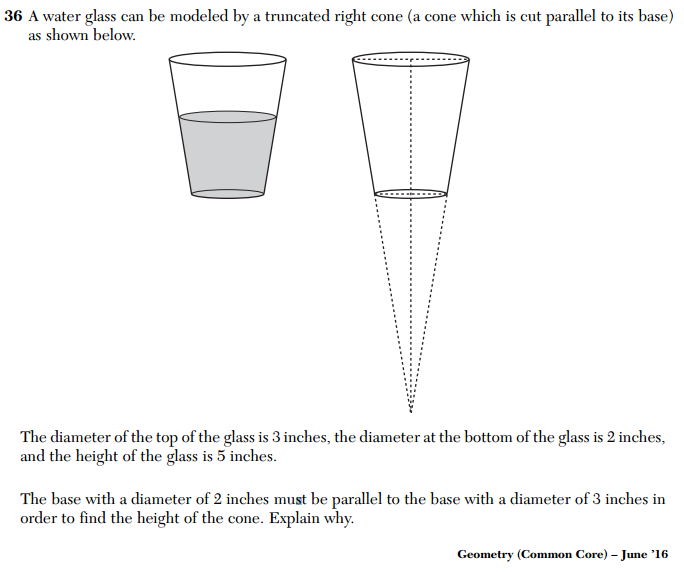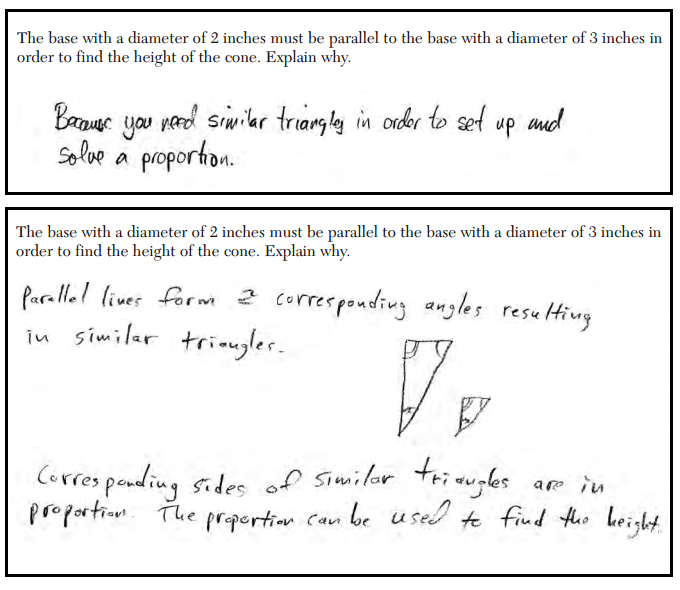Regents Recap — June 2016: What Do They Want to Hear?
I read this problem several times and still did not understand what it was asking for. It is the first part of problem 36 from the June 2016 Common Core Geometry Regents exam.
 “The base with a diameter of 2 inches must be parallel to the base with a diameter of 3 inches in order to find the height of the cone. Explain why.” Explain why? What do they want to hear?
“The base with a diameter of 2 inches must be parallel to the base with a diameter of 3 inches in order to find the height of the cone. Explain why.” Explain why? What do they want to hear?
Is the expectation that students will say something like “Height is only well-defined when measured between two parallel objects”, or “If the bases aren’t parallel, the height will vary depending on where the measurement is taken, thus height is only a meaningful measurement when the bases are parallel”? As usual, the rubric was no help, simply awarding points if A correct explanation is given.
But the model student work says it all. Here are two examples of complete and correct solutions.
 These are not explanations of why the two bases must be parallel. These are descriptions of how you might compute the height given that the two bases are parallel. This argument essentially says “The bases are parallel because in order answer this question I need to apply a technique that requires that the bases be parallel.”
These are not explanations of why the two bases must be parallel. These are descriptions of how you might compute the height given that the two bases are parallel. This argument essentially says “The bases are parallel because in order answer this question I need to apply a technique that requires that the bases be parallel.”
Not only is this not an explanation, it’s a kind of argument we want to teach students not to make. Validating these responses works against what we should be trying to do as math teachers.
These high stakes exams shouldn’t encourage teachers to promote invalid mathematical thinking. Unfortunately, as the posts below suggest, it’s happening far too often.
Related Posts
- Regents Recaps
- Regents Recap — January 2015: It’s True Because It’s True
- Regents Recap — August 2015: Modeling Data
- Regents Recap — June 2014: Common Core Algebra, “Explain your answer”
4 Comments
anon · July 14, 2016 at 7:26 pm
As a college math professor I’ve followed this series on bad Regents exam questions with interest, to get more of an idea of what mathematical experiences (some of) my students have had coming into college. (So thanks for doing this!)
And I have to say: this is one of the worst examples that I can remember in the whole series. Other questions you showed have been poorly written, or focused on strange topics or pointless vocabulary words. But (as you already point out) this one honestly shows a complete lack of understanding of *what a mathematical explanation actually is*.
MrHonner · July 15, 2016 at 7:14 am
Thanks for commenting. I’m always happy to hear when people find value in these posts, and for many different reasons!
As I’ve been looking more at the exemplar student work, I’ve noticed this validation of bogus arguments with much more frequency. Though, from start to finish, this is still the worst Regents question I’ve encountered: https://mrhonner.com/archives/5695.
Marshall Hampton · July 15, 2016 at 1:44 pm
I agree, this question is really terrible. It actually undermines understanding.
Amy Hogan · July 15, 2016 at 9:03 am
As a grader of this question, I can attest that it was very unclear what exactly would and could receive full credit for this part (due to the vague and useless rubric). I did find some students had thoughtful explanations of why the distances between the two bases must be consistent, but I also had quite a few that I graded whose responses were of the “it’s true because I need it to be true to solve this problem” variety. Why was this part even necessary for the problem? What a waste of time for the test-takers and what a waste of a potentially interesting way to scaffold this problem.
Besides the lack of mathematical validity and the unclear intent of the question’s assessment goal, the way the question is framed doesn’t lend itself to consistent grading by the teachers who are grading it all over the state. The rubric is modeling credit for responses that are not correct, but does not present examples of good mathematical thinking. That means almost certainly students who were using good geometry logic and made accurate statements were getting penalized for it. Ugh.